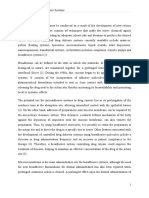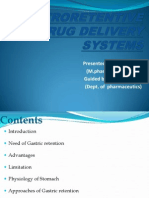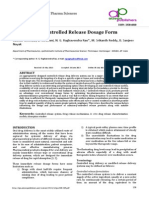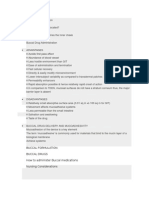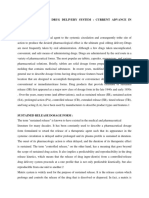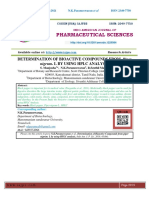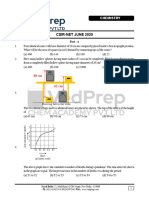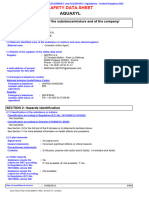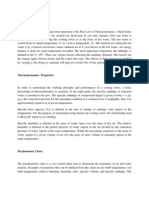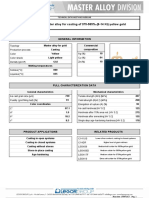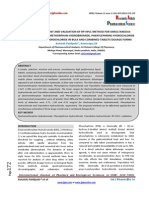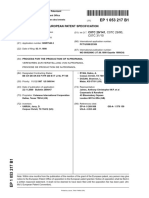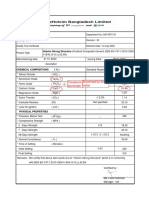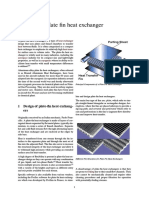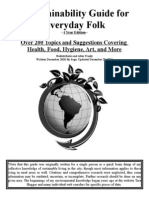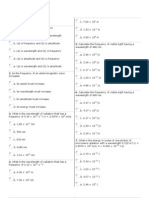12.floating Nanoparticles
12.floating Nanoparticles
Uploaded by
Baru Chandrasekhar RaoCopyright:
Available Formats
12.floating Nanoparticles
12.floating Nanoparticles
Uploaded by
Baru Chandrasekhar RaoOriginal Title
Copyright
Available Formats
Share this document
Did you find this document useful?
Is this content inappropriate?
Copyright:
Available Formats
12.floating Nanoparticles
12.floating Nanoparticles
Uploaded by
Baru Chandrasekhar RaoCopyright:
Available Formats
IAJPS 2016, 3 (9),1020-1024
Navya and A.Madhu Babu
CODEN (USA): IAJPBB
ISSN 2349-7750
ISSN: 2349-7750
INDO AMERICAN JOURNAL OF
PHARMACEUTICAL SCIENCES
Available online at: http://www.iajps.com
Review Article
FLOATING MICROSPHERES FOR GASTROINTESTINAL
DISORDERS
J.Navya, A.Madhu Babu.
Comprime Labs,chitanyapuri,Hyderabad,Telangana,India.
Abstract:
Drug absorption in the gastrointestinal tract is a highly variable process. Floating microspheres are promises
to be a potential approach for gastric retention enhances the bioavailability and controlled delivery of various
therapeutic agents. Significant attempts have been made worldwide to explore these systems according to
patient requirements, both in terms of therapeutic efficacy and compliance. Floating microspheres as gastro
retentive dosage forms precisely control the release rate of target drug to a specific site and facilitate an
enormous impact on health care. These systems also provide tremendous opportunities in the designing of new
controlled and delayed release oral formulations, thus extending the frontier of futuristic pharmaceutical
development. Furthermore, recent innovations in pharmaceutical investigation will surely provide real
prospects for establishment of novel and effective means in the development of these promising drug delivery
systems.
Keywords: Gastro Retention, Hollow microspheres, Floating microspheres, Short halflife, Solvent Diffusion,
Floating drug delivery system (FDDS).
Corresponding author:
A.Madhu Babu.
Comprime Labs,
chitanyapuri,
Hyderabad,Telangana,India.
QR code
Please cite this article in press as Navya and A.Madhu Babu, Floating Microspheres for Gastrointestinal
Disorders, Indo Am. J. P. Sci, 2016; 3(9).
www.iajps.com
Page 1020
IAJPS 2016, 3 (9),1020-1024
Navya and A.Madhu Babu
INTRODUCTION:
Gastroretentive Drug Delivery System: Oral
controlled release (CR) dosage forms (DFs) have
been developed over the past three decades due to
their considerable therapeutic advantages such as
ease of administration, patient compliance and
flexibility in formulation. However, this approach
is bedilled with several physiological difficulties
such as inability to restrain and locate the
controlled drug delivery system within the desired
region of gastrointestinal tract (GIT) due to
variable gastric emptying and motility [1-4].
Furthermore, the relatively brief gastric emptying
time (GET) in humans which normally averages 23 h through the major absorption zone, i.e.,
stomach and upper part of the intestine, can result
in incomplete drug release from the drug delivery
system leading to reduced efficacy of the
administered dose. Therefore, control on placement
of a variety of important drugs through
appropriately designed drug delivery system (DDS)
in a specific region of the GI tract offers
advantages particularly for those having a narrow
absorption window in the GIT or those with
stability problems. These considerations have led to
the development of a unique oral controlled release
dosage form with Gastroretentive properties. After
oral administration, such a DF would be retained in
the stomach and release the drug there in a
controlled and prolonged manner so that the drug
could be supplied continuously to its absorption
sites in the upper gastrointestinal tract.
Gastroretentive dosage form can remain in the
gastric region for several hours and hence
significantly prolong the gastric residence time of
drugs. Prolonged gastric retention improves
bioavailability, reduces drug waste and improves
solubility of drugs that are less soluble in a high pH
environment. It is also suitable for local drug
delivery to the stomach and proximal small
intestine [6-10].
Gastric emptying is a complex process, one that is
highly variable and that makes in vivo performance
of drug delivery systems uncertain. A controlled
drug delivery system with prolonged residence time
in the stomach can be of great practical importance
for drugs with an absorption window in the upper
small intestine. Floating or hydrodynamically
controlled drug delivery systems are useful in such
applications. Various gastroretentive dosage forms
are available, including tablets, capsules, pills,
laminated films, floating microspheres, granules
and powders. The dosage form comprises a
plurality of buoyant particles, each comprising an
inner drug-containing core, an intermediate layer
surrounding said core and a release rate-controlling
www.iajps.com
ISSN 2349-7750
outer coating. Floating microspheres have been
gaining attention due to the uniform distribution of
these multiple-unit dosage forms in the stomach,
which results in more reproducible drug absorption
and reduced risk of local irritation.
Figure 1: Drug blood level versus time profiles
Mechanism:
Most of the floating systems are single-unit
systems, which are generally unreliable and nonreproducible in prolonging the GRT, in virtue of
their unpredictable all-or-nothing emptying
process. On the other hand, multiple-unit dosage
forms appear to be better suited, since they claim to
reduce inter-subject variability in absorption and
have a lower dose-dumping probability. The
uniform distribution of these multiple unit dosage
forms along the GIT could result in more
reproducible drug absorption and reduced risk of
local irritation; this gave way to the development of
gastroretentive floating microspheres [11-13]
Floating microspheres are gastroretentive drug
delivery systems based on a non-effervescent
approach. Hollow microspheres, microballoons or
floating
microparticles
are
terms
used
synonymously for floating microspheres. Floating
microspheres are, in a strict sense, spherical empty
particles without a core. These are free-flowing
particles, with size ranging from 1 to 1000 m.
non-effervescent
hollow
polycarbonate
microspheres are developed by using an emulsion
solvent evaporation method. This gastrointestinal
transit-controlled preparation is designed to float on
gastric juice with a specific density of less than
one. This property results in delayed transit through
the stomach. The drug is released slowly at desired
rate, resulting in increased gastric retention with
reduced fluctuations in plasma drug concentration
[14].
Advantages of floating microspheres:
1. Bioavailability enhances, despite first pass
effect, because fluctuations in plasma drug
concentration are avoided, and a desirable plasma
Page 1021
IAJPS 2016, 3 (9),1020-1024
Navya and A.Madhu Babu
drug concentration is maintained by continuous
drug release.
2. Superior to single-unit floating dosage forms, as
such microspheres release drugs uniformly and
there is no risk of dose dumping.
3. Enhanced absorption of drugs that solubilise
only in stomach.
4. Site-specific drug delivery to the stomach can be
achieved.
5. Avoidance of gastric irritation, due to sustained
release effect.
6. Better therapeutic effect of short half-life drugs
can be achieved.
Disadvantage
Reproducibility of the particle size of the
formulation.
Methods
of
Preparation
of
Hollow
Microspheres:
Hollow microspheres are prepared through
the solvent diffusion and evaporation method to
create the hollow inner core. The solvent is
evaporated either by increasing the temperature
under pressure or by continuous stirring.
The floating microspheres are prepared by the
emulsion solvent diffusion method, utilizing enteric
acrylic polymers dissolved with drug in a mixture
of dichloromethane and ethanol. The above
solution was introduced in the aqueous solution of
polyvinyl alcohol at 40 C with constant stirring to
form an oil-in-water (o/w) emulsion. After
agitating the system for 1 hour, the resulting
polymeric particulate systems were sieved between
500 and 1000 mm and then dried overnight at 40 C
to produce hollow microspheres.
A novel two step manufacturing process of hollow,
poly-butyl-2-cyanoacrylate (PBCA) microspheres
in an aqueous phase was developed to synthesize
gas-filled
hollow
microspheres.
These
microspheres have an organic shell. The first step is
the
polymerization
process
of n-butyl-2cyanoacrylate (BCA) to form nanoparticles. During
the second step, the nanoparticles attach on a
microbubble precursor and finally form hollow
microspheres.
Cellulose acetate, chitosan, Eudragit, Acrycoat,
Methocel, polyacrylates, polyvinyl acetate,
Carbopol,
agar,
polyethylene
oxide,
polycarbonates, acrylic resins and polyethylene
oxide are some of the polymers used in the
preparation of hollow microspheres.
Mechanism
of
formation
of
hollow
microspheres
Ethanol and methanol have been found to be good
solvents for most drugs and polymers.
Dichloromethane and chloroform are good bridging
www.iajps.com
ISSN 2349-7750
liquids due to the good linkage between the drug
and polymers and to their immiscibility in the
external
phase.
Water-insoluble
polymers,
mentioned above, show higher solubility in
dichloromethane than ethanol. However, ethanol
has higher solubility in water. As soon as the
polymer solution was added to the aqueous
medium, the ethanol diffuses rapidly from the
droplets of the polymer solution. Simultaneous
diffusion of water inside the sphere further
decreased the ethanol concentration, hence the
polymer precipitated, resulting in the formation of
microspheres. Dichloromethane remaining as the
central core diffused slowly due to its low water
solubility. Therefore, the diffusion of ethanol
played an important role in determining the size
and shape of the microspheres.
Mechanism of gastro retention
When microspheres come in contact with gastric
fluid, the gel formers, polysaccharides, and
polymers hydrate to form a colloidal gel barrier that
controls the rate of fluid penetration into the device
and drug release. As the exterior surface of the
dosage form dissolves, the gel layer is maintained
by the hydration of the adjacent hydrocolloid layer.
The air trapped by the swollen polymer lowers the
density and confers buoyancy to the microspheres.
However, a minimal gastric content is needed to
allow proper achievement of buoyancy.
Characterization/evaluation
microspheres
of
floating
Particle size
Size is measured using an optical microscope, and
mean particle size is calculated by measuring 200
300 particles with the help of a calibrated ocular
micrometer
Tapped density and compressibility index
The tapping method is used to determine the tapped
density and percentage compressibility index, as
follows
Page 1022
IAJPS 2016, 3 (9),1020-1024
Navya and A.Madhu Babu
ISSN 2349-7750
where V and Vo are the volumes of the sample after
and before the standard tapping, respectively.
microspheres of indomethacin are quite beneficial
for rheumatic patients.
Floating behaviour
The floating test on the microspheres is carried out
using the dissolution method II apparatus, specified
in the USP XXII. The microspheres are spread over
the surface of the dispersing medium (900 ml),
which is agitated by a paddle rotated at 100 rpm.
Disintegration test solution No. 1 (pH 1.2),
containing Tween 20 (0.02%, w/v), is used as a
dispersing medium to simulate gastric fluid. After
agitation for a previously determined interval, the
hollow microspheres that floated over the surface
of medium and those that settled to the bottom of
the flask are recovered separately. After drying,
each fraction of the hollow microspheres is
weighed. The buoyancy of the hollow microspheres
is represented by the following equation.
3. Floating microspheres are especially effective in
the delivery of sparingly soluble and insoluble
drugs. It is known that as the solubility of a drug
decreases, the time available for drug dissolution
becomes less adequate, and thus transit time
becomes a significant factor affecting drug
absorption.
where Qf and Qs are the weights of the floating and
settled hollow microspheres, respectively.
CONCLUSION:
Floating microspheres has emerged as an efficient
approach for enhancing the bioavailability and
controlled delivery of various therapeutic agents.
Significant attempts have been made worldwide to
explore these systems according to patient
requirements, both in terms of therapeutic efficacy
and compliance. Floating microspheres as gastro
retentive dosage forms precisely control the release
rate of target drug to a specific site and facilitate an
enormous impact on health care. Optimized multiunit floating microspheres are expected to provide
clinicians with a new choice of an economical, safe
and more bioavailable formulation in the effective
management of diverse diseases. These systems
also provide tremendous opportunities in the
designing of new controlled and delayed release
oral formulations, thus extending the frontier of
futuristic pharmaceutical development. Increased
sophistication of this system will ensure the
successful advancements in the avenue of gastro
retentive microspheres therapy so as to optimize
the delivery of molecules in a more efficient
manner.
In vitro release studies
In vitro dissolution studies can be carried out in a
USP
paddle
type
dissolution
assembly.
Microspheres equivalent to the drug dose are added
to 900 ml of the dissolution medium and stirred at
100 rpm at 37 0.5 C. Samples are withdrawn at a
specified time interval and analyzed by any suitable
analytical method, such as UV spectroscopy or
HPLC, etc.
In vivo studies
In vivo studies are generally conducted in healthy
male albino rabbits weighing 2-2.5 kg. The animals
are fasted for 24 hours before the experiments;
however, they are given free access to food and
water during the experiments. Blood samples (2
mL) are collected from the marginal ear vein into
heparinized centrifuge at an appropriate time
interval
Applications of floating microspheres
1. Floating microspheres can be used as carriers for
drugs with so-called absorption windows
for example antiviral, antifungal and antibiotic
agents (sulphonamides, quinolones, penicillins,
cephalosporins, aminoglycosides and tetracyclines)
are taken up only from very specific sites of the GI
mucosa.
2. Hollow microspheres of non-steroidal antiinflammatory drugs are very effective for
controlled release, and reduce the major side effect
of gastric irritation. For example, floating
www.iajps.com
4. The gastroretentive floating microspheres will
beneficially alter the absorption profile of the
active agent, thus enhancing its bioavailability.
5. Hollow microspheres can greatly improve the
pharmacotherapy of the stomach through local drug
release, leading to high drug concentrations at the
gastric mucosa, thus eradicating Helicobacter
pylori from the sub-mucosal tissue of the stomach
and making it possible to treat stomach and
duodenal ulcers, gastritis and oesophagitis.
REFERENCES:
1. Praveen Nasa, Sheefali Mahant, Deepika
Sharma, Floating Systems: A Novel Approach
Towards Gastroretentive Drug Delivery Systems,
Int J Pharmacy and Pharm Sci, 2010; 2 (3): 27.
2.
Brahamankar
D.M;
Jaiswal
S.B;
Biopharmaceutics and Pharmacokinetics: A
treatise Ist edition, 1995, pp. 399.
3. Chawla G; Gupta P; KoradiaV; And Bansal A.
K; Gastro retention: A Means to Address Regional
Page 1023
IAJPS 2016, 3 (9),1020-1024
Navya and A.Madhu Babu
Variability in Intestinal Drug Absorption
Pharmaceutical Technology, 2003, pp. 50-52.
4. Kavitha K, Sudhir K Yadav, Tamizh Mani T,
The Need of Floating Drug Delivery System,
Research Journal of Pharmaceutical, Biological and
Chemical Sciences, 2010; volume 1, Issue 2, page
no: 396. 5. S. H. Shaha, J.K. Patel, K.
Pundarikakshudu, An overview of a gastroretentive floating drug delivery system, Asian
Journal of Pharmaceutical Sciences 2009, 4(1): 6580. The Journal of Phytopharmacology 12
6. S. U. Zate, P.L. Kothawade, G.H.Mahale,
Gastro Retentive Bioadhesive Drug Delivery
System: A Review, Int. J. PharmTech Res. 2010,
2(2):12-19.
7. Chawla C, Gupta P, Koradia V, Bansal AK,
Gastroretention: A Means to Address Regional
Variability in intestinal drug Absorption.
Pharmaceutical technology, 2003;27(2):50-68.
www.iajps.com
ISSN 2349-7750
8. Sangekar S. Evaluation of effect of food and
specific gravity of the tablets on gastric retention
time. Int J Pharm 1987;35(3):34-53.
9. Yyas SP, Khar RK. Controlled Drug Delivery
Concepts and Advances. 1st Edition, New
Delhi:2002;196-217.
10. Jain NK. Progress in Controlled and Novel
Drug Delivery Systems, 1stEd. CBS Publishers and
Distributors, New Delhi, Bangalore, 2004; 84-85.
11. Chawla G, Gupta P, Koradia V, Bansal AK.
Pharm Tech 2001;27(7):50-51.
12. Debjit B, Chiranjib B, Margret C, B Jayakar.
Floating Drug Delivery System: A Review. Der
Pharmacia Lettre, 2009; 1(2): 199-218.
13. Chawla G, Gupta P, Koradia V, Bansal AK.
Floating Drug Delivery Systems: An approach to
Gastro retention, Pharm. Tech, 2003; 27(2): 50-68.
14. Garg R, Gupta GD. Progress in Controlled
Gastro retentive Delivery Systems, Trop. J.
Pharma. Res, 2008; 7(3): 1055-1066.
Page 1024
You might also like
- 1000 Mcqs - Operative & Endodontics Plus September 2014 McqsDocument39 pages1000 Mcqs - Operative & Endodontics Plus September 2014 McqsN60% (10)
- Kasus Gagal Ginjal AkutDocument8 pagesKasus Gagal Ginjal Akutdian oktavianiNo ratings yet
- Floating Drug Delivery SystemDocument12 pagesFloating Drug Delivery SystemShaikat Kumar SinhaNo ratings yet
- Gastro Retentive Drug Delivery SystemDocument20 pagesGastro Retentive Drug Delivery SystemokNo ratings yet
- Advance Pharmaceutics Topic: Floating Drug Delivery System Group No. 10Document9 pagesAdvance Pharmaceutics Topic: Floating Drug Delivery System Group No. 10Noor ChwdriiNo ratings yet
- 698 PDF PDFDocument8 pages698 PDF PDFMuh Indra SudirjaNo ratings yet
- 23 Ref For FloatingDocument9 pages23 Ref For FloatingLakshmiNo ratings yet
- Concepts of Buccal Drug Delivery System: Bioadhesion and MucoadhesionDocument6 pagesConcepts of Buccal Drug Delivery System: Bioadhesion and Mucoadhesionpathuri rangaNo ratings yet
- 24 RJPT 6 12 2013Document7 pages24 RJPT 6 12 2013Sagar FirkeNo ratings yet
- Final Synopsis PHDDocument13 pagesFinal Synopsis PHDKishor KanaseNo ratings yet
- Floating Tablets and Its PolymersDocument9 pagesFloating Tablets and Its PolymersN. IndupriyaNo ratings yet
- Gastroretentive Microballoons: A Novel Approach For Drug DeliveryDocument9 pagesGastroretentive Microballoons: A Novel Approach For Drug DeliveryprinceamitNo ratings yet
- Syahri Septiana RevisiDocument15 pagesSyahri Septiana RevisiSyahri SeptianaNo ratings yet
- IJPSR LibreDocument5 pagesIJPSR LibreWahyu RedfieldNo ratings yet
- In Vitro and in Vivo Test Methods For The Evaluation of Gastroretentive Dosage FormsDocument29 pagesIn Vitro and in Vivo Test Methods For The Evaluation of Gastroretentive Dosage FormsAnton SikorskyiNo ratings yet
- Floating Drug Delivery System ThesisDocument4 pagesFloating Drug Delivery System Thesisvxjtklxff100% (2)
- Floating Microspheres-A ReviewDocument11 pagesFloating Microspheres-A ReviewAgus Agus Syamsur RijalNo ratings yet
- Gastroretentive-Drug-Delivery-System L-13 L-59 L-67 L-01 L-46Document9 pagesGastroretentive-Drug-Delivery-System L-13 L-59 L-67 L-01 L-46Bilal AsgharNo ratings yet
- Multi-Layer TabletsDocument14 pagesMulti-Layer Tabletsprasad_ram8850% (2)
- Chapter 1 IntroductionDocument16 pagesChapter 1 IntroductionSandeepNo ratings yet
- Mucoadhesive Drug Delivery System - Project PaperDocument43 pagesMucoadhesive Drug Delivery System - Project Papershafi_jp100% (1)
- Review ArticleDocument9 pagesReview ArticlemickydivyaNo ratings yet
- Ishan 1Document75 pagesIshan 1Arshdeep SinghNo ratings yet
- Dosage Forms 2Document91 pagesDosage Forms 2Palak BatraNo ratings yet
- Gastroretentive Drug Delivery SystemDocument33 pagesGastroretentive Drug Delivery SystemSaid Muhammad WazirNo ratings yet
- Assigment Controlled Drug Delivery SystemDocument5 pagesAssigment Controlled Drug Delivery SystemZainab AbdullahiNo ratings yet
- Pharmaceutics 11 00095Document24 pagesPharmaceutics 11 00095fruitsbasketNo ratings yet
- Matrix Tablets ThesisDocument4 pagesMatrix Tablets Thesisafbtbegxe100% (2)
- Oral Controlled Drug Delivery Systems by RKDocument34 pagesOral Controlled Drug Delivery Systems by RKRamu KrishnaNo ratings yet
- Gastroretentive Drug Delivery System A ReviewDocument13 pagesGastroretentive Drug Delivery System A Reviewtusharydv72023No ratings yet
- The Pharma Innovation - Journal Floating Drug Delivery System: A Novel ApproachDocument13 pagesThe Pharma Innovation - Journal Floating Drug Delivery System: A Novel Approachdian oktavianiNo ratings yet
- Chapter 9Document66 pagesChapter 9Geline Anne BenozaNo ratings yet
- Gastro Retentive Drug Delivery SystemDocument10 pagesGastro Retentive Drug Delivery SystemKrunal SamejaNo ratings yet
- Floating Drug Delivery System: A ReviewDocument7 pagesFloating Drug Delivery System: A ReviewIJAR JOURNALNo ratings yet
- A Prolonged Release Parenteral Drug Delivery SystemDocument11 pagesA Prolonged Release Parenteral Drug Delivery SystemronnymcmNo ratings yet
- Crps 4Document16 pagesCrps 4Earthjournal PublisherNo ratings yet
- Thesis On Floating Drug Delivery SystemDocument4 pagesThesis On Floating Drug Delivery Systemkarenhenningssiouxfalls100% (2)
- Presented By: Akash Aher (M.pharm - 2 Semester) Guided By: DR.G.S Asane (Dept. of Pharmaceutics)Document36 pagesPresented By: Akash Aher (M.pharm - 2 Semester) Guided By: DR.G.S Asane (Dept. of Pharmaceutics)azizah_muliawati100% (1)
- Extended Release Formulation: Available Online ThroughDocument60 pagesExtended Release Formulation: Available Online ThroughSomasundaram JeevanandhamNo ratings yet
- Invitro-Invivo Correlation On Parenteral Dosage Forms PDFDocument23 pagesInvitro-Invivo Correlation On Parenteral Dosage Forms PDFvijayns_250355172No ratings yet
- 7TH SEM Subhojit Panja Novel Drug Delivery SystemDocument6 pages7TH SEM Subhojit Panja Novel Drug Delivery Systembp21.0283No ratings yet
- BCS REg ApproachDocument7 pagesBCS REg Approachvg_vvgNo ratings yet
- Sustained Release Drug Delivery System - A ReviewDocument14 pagesSustained Release Drug Delivery System - A ReviewPranav PatelNo ratings yet
- Design and Development of Carvedilol Gastroretentive Floating Drug Delivery Systems Using Hydrophilic Polymers and in Vitro CharacterizationDocument8 pagesDesign and Development of Carvedilol Gastroretentive Floating Drug Delivery Systems Using Hydrophilic Polymers and in Vitro CharacterizationPRASANTA KUMAR MOHAPATRANo ratings yet
- Rectal SuppositoriesDocument6 pagesRectal SuppositoriesLinh PhamNo ratings yet
- Design and Evaluation of Gastro Retentive Drug Deliverry System of Anti Ulcer DrugDocument6 pagesDesign and Evaluation of Gastro Retentive Drug Deliverry System of Anti Ulcer DrugmindaNo ratings yet
- Modified-Release Dosage Forms and Drug Delevery SystemsDocument52 pagesModified-Release Dosage Forms and Drug Delevery SystemsFria Mariz SuperalesNo ratings yet
- Colon Targeted Drug Delivery SystemsDocument14 pagesColon Targeted Drug Delivery SystemsGajendra GowdaNo ratings yet
- 6.0 Brief Resume of The Intended Work Enclosure - I 6.1 Need For The StudyDocument8 pages6.0 Brief Resume of The Intended Work Enclosure - I 6.1 Need For The StudyAndrian SumanNo ratings yet
- Ijps258 269Document12 pagesIjps258 269Kristine Dwi PuspitasariNo ratings yet
- Sustained ReleasedDocument25 pagesSustained ReleasedKhalid HussainNo ratings yet
- Floating Effervescent Tablets A ReviewDocument6 pagesFloating Effervescent Tablets A ReviewsherepunjabNo ratings yet
- Buccal Drug Administration ModuleDocument7 pagesBuccal Drug Administration ModuleJanine PleteNo ratings yet
- GRDDS - Modulation To Gi TransitDocument54 pagesGRDDS - Modulation To Gi TransitrajaNo ratings yet
- SRDDS Matrix TabletDocument17 pagesSRDDS Matrix TabletMISBAH KAUSARNo ratings yet
- Gastroretentive Dosage Forms: A Review With Special Emphasis On Floating Drug Delivery SystemsDocument15 pagesGastroretentive Dosage Forms: A Review With Special Emphasis On Floating Drug Delivery Systemstsamrotul layyinahNo ratings yet
- 11 SaplasticDocument37 pages11 Saplasticblain mathewNo ratings yet
- Microneedle-mediated Transdermal and Intradermal Drug DeliveryFrom EverandMicroneedle-mediated Transdermal and Intradermal Drug DeliveryNo ratings yet
- NANOTECHNOLOGY REVIEW: LIPOSOMES, NANOTUBES & PLGA NANOPARTICLESFrom EverandNANOTECHNOLOGY REVIEW: LIPOSOMES, NANOTUBES & PLGA NANOPARTICLESNo ratings yet
- Biopharmaceutics Modeling and Simulations: Theory, Practice, Methods, and ApplicationsFrom EverandBiopharmaceutics Modeling and Simulations: Theory, Practice, Methods, and ApplicationsNo ratings yet
- Development and Validation of Stability Indicating Assay Method For Estimation of Teriflunomide in Tablet Dosage FormDocument11 pagesDevelopment and Validation of Stability Indicating Assay Method For Estimation of Teriflunomide in Tablet Dosage FormBaru Chandrasekhar RaoNo ratings yet
- Gastroprotective Activity of Methanolic Extract of Phyllanthus Acidus Fruit Against Indomethacin-Induced Gastric Ulcers in RatsDocument7 pagesGastroprotective Activity of Methanolic Extract of Phyllanthus Acidus Fruit Against Indomethacin-Induced Gastric Ulcers in RatsBaru Chandrasekhar RaoNo ratings yet
- Analytical Method Development and Validation of Stability Indicating RP-HPLC Method For Estimation of Lercanidipine Hydrochloride and Enalapril Maleate in CombinationDocument8 pagesAnalytical Method Development and Validation of Stability Indicating RP-HPLC Method For Estimation of Lercanidipine Hydrochloride and Enalapril Maleate in CombinationBaru Chandrasekhar RaoNo ratings yet
- Review On: Inventory ManagementDocument8 pagesReview On: Inventory ManagementBaru Chandrasekhar RaoNo ratings yet
- A Brief Review On YawsDocument7 pagesA Brief Review On YawsBaru Chandrasekhar RaoNo ratings yet
- Assessment of Correlation Between Physical Activity and Academic Performance Among The Students of Gujranwala Medical College, GujranwalaDocument7 pagesAssessment of Correlation Between Physical Activity and Academic Performance Among The Students of Gujranwala Medical College, GujranwalaBaru Chandrasekhar RaoNo ratings yet
- Descriptive Study Knowing The Patients Load in The Neonatal Icu at The Tertiary Care Hospital LahoreDocument4 pagesDescriptive Study Knowing The Patients Load in The Neonatal Icu at The Tertiary Care Hospital LahoreBaru Chandrasekhar RaoNo ratings yet
- Relationship of Testosterone With Body Mass Index in Infertile Males in Local CommunityDocument4 pagesRelationship of Testosterone With Body Mass Index in Infertile Males in Local CommunityBaru Chandrasekhar RaoNo ratings yet
- Pharmaceutical Sciences: IAJPS 2018, 05 (04), 3075-3081 Aneeqa Ali RaoDocument7 pagesPharmaceutical Sciences: IAJPS 2018, 05 (04), 3075-3081 Aneeqa Ali RaoBaru Chandrasekhar RaoNo ratings yet
- Pharmacological and Phytochemical Evidence of Scutia Genus Plants - A ReviewDocument7 pagesPharmacological and Phytochemical Evidence of Scutia Genus Plants - A ReviewBaru Chandrasekhar RaoNo ratings yet
- Determination of Bioactive Compounds From Piper Nigrum L by Using Ft-Ir Spectroscopic AnalysisDocument3 pagesDetermination of Bioactive Compounds From Piper Nigrum L by Using Ft-Ir Spectroscopic AnalysisBaru Chandrasekhar RaoNo ratings yet
- The Role of Clinical Pharmacist in Pharmacovigilance and Drug Safety in Teritiary Care Teaching HospitalDocument11 pagesThe Role of Clinical Pharmacist in Pharmacovigilance and Drug Safety in Teritiary Care Teaching HospitalBaru Chandrasekhar RaoNo ratings yet
- DISTINCTIVE PHARMACOLOGICAL ACTIVITIES OF Eclipta Alba AND IT'S COUMESTAN WEDELOLACTONEDocument7 pagesDISTINCTIVE PHARMACOLOGICAL ACTIVITIES OF Eclipta Alba AND IT'S COUMESTAN WEDELOLACTONEBaru Chandrasekhar RaoNo ratings yet
- Determination of Bioactive Compounds From Piper Longum L. by Using HP-LC AnalysisDocument4 pagesDetermination of Bioactive Compounds From Piper Longum L. by Using HP-LC AnalysisBaru Chandrasekhar RaoNo ratings yet
- RP-HPLC Method Development and Validation of Alogliptin Bulk and Tablet Dosage FormDocument8 pagesRP-HPLC Method Development and Validation of Alogliptin Bulk and Tablet Dosage FormBaru Chandrasekhar RaoNo ratings yet
- STUDIES ON QUALITATIVE PHYTOCHEMICAL ANALYSIS AND ANTIBACTERIAL ACTIVITY OF Piper NigrumDocument7 pagesSTUDIES ON QUALITATIVE PHYTOCHEMICAL ANALYSIS AND ANTIBACTERIAL ACTIVITY OF Piper NigrumBaru Chandrasekhar RaoNo ratings yet
- DETERMINATION OF BIOACTIVE COMPOUNDS FROM Piper Nigrum. L BY USING HPLC ANALYSISDocument3 pagesDETERMINATION OF BIOACTIVE COMPOUNDS FROM Piper Nigrum. L BY USING HPLC ANALYSISBaru Chandrasekhar RaoNo ratings yet
- TIMCAL Brochure Fuel CellsDocument8 pagesTIMCAL Brochure Fuel Cellsjanakiram2010No ratings yet
- CSIR-NET June-2020Document51 pagesCSIR-NET June-2020PURAN MEHERNo ratings yet
- The Cultivation of White Oyster MushroomsDocument17 pagesThe Cultivation of White Oyster MushroomsJohn Mark NovenoNo ratings yet
- (Handbook of Experimental Pharmacology 82) R. S. Yalow (Auth.), Carlo Patrono, Bernhard A. Peskar (Eds.) - Radioimmunoassay in Basic and Clinical Pharmacology-Springer-Verlag Berlin Heidelberg (19 PDFDocument624 pages(Handbook of Experimental Pharmacology 82) R. S. Yalow (Auth.), Carlo Patrono, Bernhard A. Peskar (Eds.) - Radioimmunoassay in Basic and Clinical Pharmacology-Springer-Verlag Berlin Heidelberg (19 PDFfernando sanchezNo ratings yet
- Ujikom - Sop Spektronik 20 PDFDocument2 pagesUjikom - Sop Spektronik 20 PDFArmyAdisNo ratings yet
- AquaxylDocument10 pagesAquaxylthuyuyenbt11112000No ratings yet
- Cooling Tower T P ADocument6 pagesCooling Tower T P AZulhisham ZainiNo ratings yet
- AntsDocument21 pagesAntsSerajul SalekinNo ratings yet
- Chapter 2 Design of Water Treatment Plants PDFDocument55 pagesChapter 2 Design of Water Treatment Plants PDFwedjefdbenmcveNo ratings yet
- Bd18 Ficha TecnicaDocument2 pagesBd18 Ficha TecnicaGorch MarrokoNo ratings yet
- What Is PhotosynthesisDocument4 pagesWhat Is PhotosynthesisJohn Dulay MendozaNo ratings yet
- Title 14 KT: Master Alloy For Casting of 375-585 (9-14 KT) Yellow GoldDocument2 pagesTitle 14 KT: Master Alloy For Casting of 375-585 (9-14 KT) Yellow GoldTony BrutiglianoNo ratings yet
- 2021-2022 S3 AE AnswersDocument12 pages2021-2022 S3 AE AnswersEndi WongNo ratings yet
- Kotaiah - Paidipala, Kamarapu - SK: Available Online ThroughDocument8 pagesKotaiah - Paidipala, Kamarapu - SK: Available Online ThroughLandyyun Rahmawan SNo ratings yet
- Aqa Chm6x QP Jun12Document12 pagesAqa Chm6x QP Jun12Georgiana CrivatNo ratings yet
- Hydrogenation of PropionaldehydeDocument8 pagesHydrogenation of PropionaldehydeNur Zafirah Binti Mohamad FoziNo ratings yet
- Cement Test ReportDocument1 pageCement Test ReportNazmul HudaNo ratings yet
- Plate Fin Heat ExchangerDocument3 pagesPlate Fin Heat ExchangerRaju KalinthaNo ratings yet
- Manual Secadora GE DCVH515GF1WWDocument56 pagesManual Secadora GE DCVH515GF1WWDaniel RomeroNo ratings yet
- Bathing Soap ProductionDocument3 pagesBathing Soap ProductionFreedom AdishiNo ratings yet
- A Sustainability Guide For Everyday FolkDocument16 pagesA Sustainability Guide For Everyday FolkwhsprzNo ratings yet
- Chang Chemistry - Assessment Chapter 7Document10 pagesChang Chemistry - Assessment Chapter 7haha_le12No ratings yet
- Wang G-sensorREv 2008 PDFDocument12 pagesWang G-sensorREv 2008 PDFjiviyanaNo ratings yet
- Assignment 3Document2 pagesAssignment 3api-3802845No ratings yet
- ChicoryDocument9 pagesChicorySkriikkNo ratings yet
- ROV Tools RequirementDocument8 pagesROV Tools RequirementKufre2No ratings yet
- Chapter 11 / Phase Transformations: T Im E-T em Perature D Ia-Gram S For Irons and Steels, G - F. VanderDocument1 pageChapter 11 / Phase Transformations: T Im E-T em Perature D Ia-Gram S For Irons and Steels, G - F. VanderAuri Rico Martinez100% (1)
- SwasakudoripaperDocument8 pagesSwasakudoripaperBeodevanahalliNo ratings yet
- Spec Sheet For NCR18650BF: TentativeDocument5 pagesSpec Sheet For NCR18650BF: TentativeAshish AgarwalNo ratings yet




















